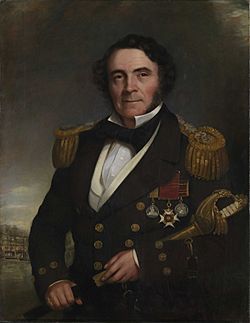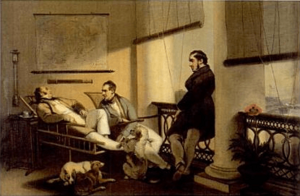William Hutcheon Hall facts for kids
Quick facts for kids
William Hutcheon Hall
|
|
|---|---|

Hall carrying a sword presented to him by the crew of the Nemesis. In the background is the bombardment of Bomarsund.
|
|
| Nickname(s) | Nemesis Hall |
| Born | c. 1797 Berwick, Northumberland, England |
| Died | 25 June 1878 (aged 80–81) Kensington, London, England |
| Buried |
St Lawrence's Church, England
|
| Allegiance | United Kingdom |
| Service/ |
Royal Navy |
| Years of service | 1811–1866 |
| Rank | Admiral |
| Wars | First Anglo-Chinese War Crimean War |
| Awards | China War Medal (1843) Fellow of the Royal Society (1847) Companion of the Order of the Bath (1855) Baltic Medal (1856) Knight Commander of the Order of the Bath (1867) |
Sir William Hutcheon Hall (born around 1797 – died 25 June 1878) was a brave officer in the Royal Navy, the United Kingdom's navy. He fought in two important wars: the First Anglo-Chinese War and the Crimean War. He was also one of the first British officers to deeply study how steam engines worked. In China, he famously commanded an iron steamship called the Nemesis. Even though it wasn't a regular Royal Navy warship, the navy allowed his time on the Nemesis to count towards his service, just as if he had been on one of their own ships.
Contents
William Hall was born in Berwick-upon-Tweed, England, around 1797. He joined the Royal Navy when he was about 14 years old, in October 1811. He started as a volunteer on a ship called HMS Warrior.
Later, he served as a midshipman, a junior officer, and even visited China as part of an official trip. After returning to England, he joined a frigate, HMS Iphigenia, which was part of the West Africa Squadron. This squadron worked to stop the illegal slave trade. He was promoted to master, a rank for officers skilled in navigation, and served in different parts of the world until 1836.
Hall was very interested in new technology. He studied steam engines in Scotland and even worked on steamboats in the United States. This knowledge would become very useful in his later career.
Service in China
In November 1839, Hall took command of the Nemesis, a special iron steamship owned by the British East India Company. He served with this ship during the First Opium War (1839–1842) in China. His bravery and skill during this war were highly praised.
Because of his excellent service, the navy made him a lieutenant in 1841. They also made sure his time on the Nemesis counted as official navy service.
Key Battles in China
- Second Battle of Chuenpi: The Nemesis first saw action on January 7, 1841, fighting against Chinese forts and ships. Hall was mentioned in official reports for his part in this battle.
- Other Engagements: He also fought in the Battle of First Bar and the Broadway expedition.
Because of his famous service with the Nemesis, he became known in the navy as "Nemesis Hall." An Oxford graduate named William Dallas Bernard even used Hall's notes to write a book about the war, called Narrative of the Voyages and Services of the Nemesis from 1840 to 1843. Hall was promoted to captain in October 1842.
Fighting in Russia
When the Crimean War (1853–1856) started against Russia, Captain Hall took command of a smaller ship, the 6-gun paddle steamer, HMS Hecla, in March 1854. He was sent to the Baltic Sea and was again mentioned for his bravery, even getting slightly wounded.
Later, in November 1854, he moved to a larger ship, HMS Blenheim. In 1855, he helped capture Bomarsund, a fortress. Even a Russian Grand Duke, Konstantin Nikolayevich, admired Hall's daring actions, saying it was "the most daring I could have imagined." For his courage, Hall received an important award, becoming a Companion of the Order of the Bath in July 1855.
Inventions and Later Life
William Hall was a true innovator. He was one of the first British officers to really understand and study steam engines. He invented special iron tanks for ships, which the navy started using. He also designed his own "Hall's patent anchor," a new type of anchor.
In 1845, he married Hilare Caroline Byng. They had one daughter, Frances Russell Hall. Frances later married Captain Charles Davis Lucas, who had won the Victoria Cross (the highest award for bravery) while serving under Hall.
Hall continued to serve the country in different ways. In 1847, he was elected a Fellow of the Royal Society, a group of important scientists. He wrote about how to improve national defenses and how to use boatmen and fishermen to help the navy. He also supported the Shipwrecked Mariners' Society for many years, helping sailors in need.
He continued to be promoted, becoming a rear admiral in 1863. He retired from active service in 1866 and received another high honor, becoming a Knight Commander of the Order of the Bath. He was promoted to vice admiral in 1869 and finally to admiral in 1875, even though he was retired.
Admiral Sir William Hutcheon Hall passed away on June 25, 1878, in London, at the age of 80 or 81. He was buried in Kent, England.
Selected Writings
William Hall also contributed to books and wrote some of his own:
- Bernard, W. D.; Hall, W. H. (1844). Narrative of the Voyages and Services of the Nemesis from 1840 to 1843. This book, based on Hall's notes, tells the story of the Nemesis in China.
- Hall, W. H. (1852). Sailors' Homes, Their Origin and Progress.
- Hall, W. H. (1876). Our National Defences.




